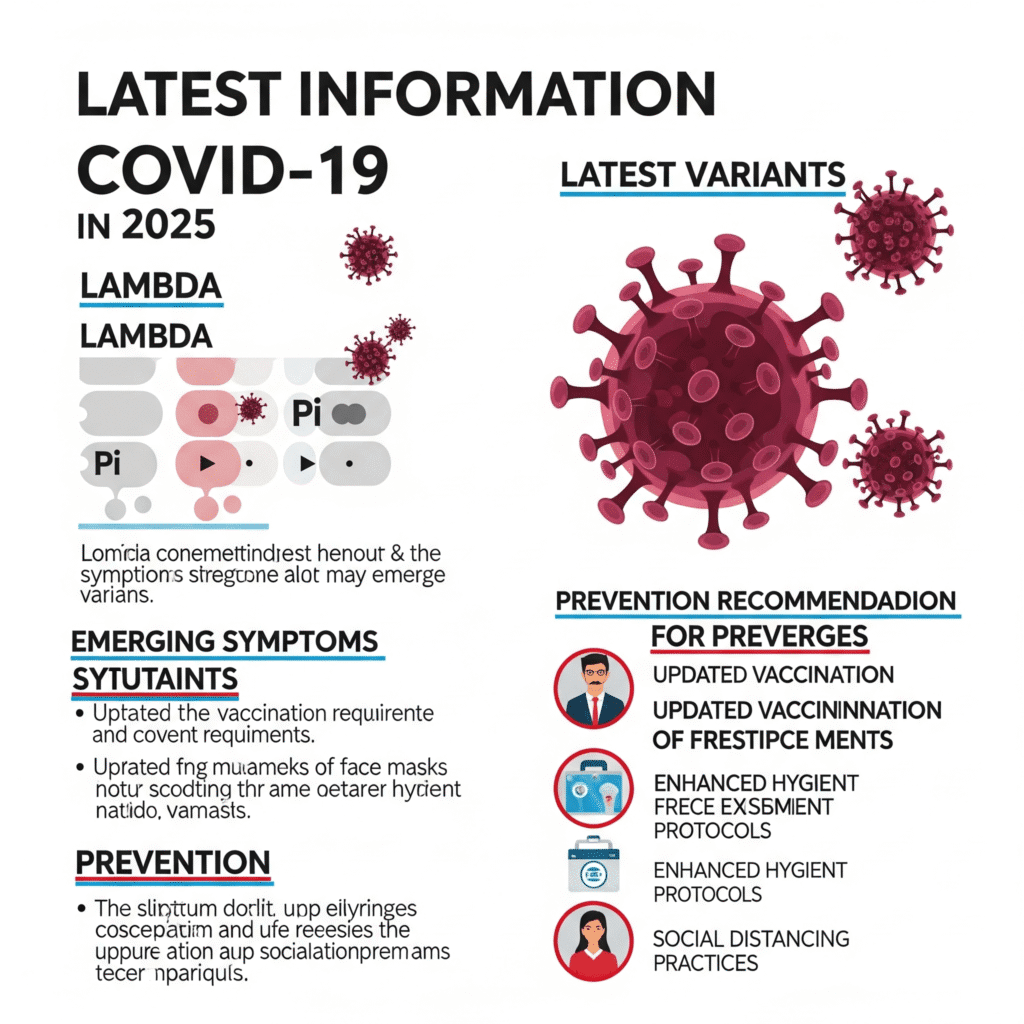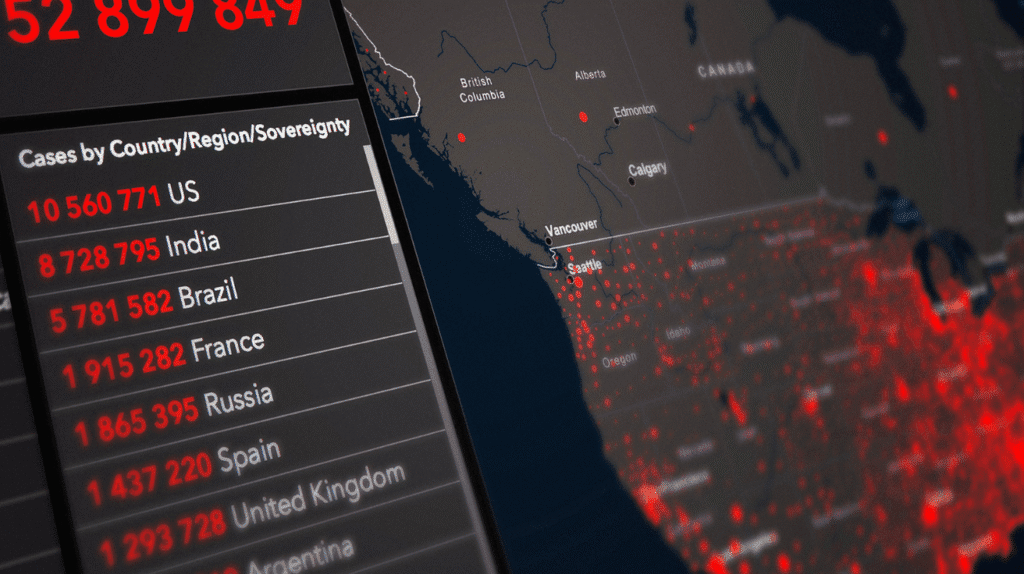Think COVID-19 is old news? While it might not dominate headlines like it once did, the virus is still very much a part of our world. Just like the flu, it’s evolved, adapted, and continues to pose a threat, especially to certain groups. Understanding COVID-19 in 2025 means staying updated on its latest forms, recognizing its symptoms, and knowing the best ways to protect oneself and loved ones. This report will break down the current variant landscape, shed light on what symptoms to watch for (including the persistent challenge of Long COVID), and offer practical, actionable advice on prevention to help individuals navigate the year ahead with confidence.
Table of Contents
ToggleThe Evolving Reality of COVID-19 in 2025

COVID-19’s Current Status: A Manageable Threat
Experts widely agree that COVID-19 has transitioned from an acute emergency to an endemic state, circulating at more predictable levels, much like seasonal influenza. While the virus retains its capacity for evolution and remains a constant threat, the severity of infection generally remains relatively low for most people. This reduced severity is largely attributable to widespread immunity acquired from prior infections and multiple vaccine doses.
However, this perceived manageability comes with a crucial caveat. The virus continues to cause severe disease, post-COVID-19 condition (PCC), and death, particularly among vulnerable populations such as older adults, individuals with underlying medical conditions, and those who are immunocompromised. The consensus on COVID-19 being an “endemic, manageable threat” marks a significant shift from the initial pandemic response, implying a move away from emergency measures towards integrating COVID-19 into routine public health. This transition means public health efforts must become more targeted. The challenge is no longer solely containing a widespread outbreak, but ensuring that at-risk groups receive adequate protection, information, and care, especially as the general public may feel less urgency. This creates a critical communication and equity challenge, where a perception of “manageable” could inadvertently lead to complacency, potentially increasing risk for those who remain susceptible.
Global Epidemiological Snapshot: A Complex Picture
Recent data from early 2025, specifically the four-week period from January 6 to February 2, 2025, reveals a global decrease in new reported cases by 16%, with over 147,000 new cases compared to the preceding 28-day period. Hospitalizations also saw a significant decrease of 40%, and ICU admissions dropped by 31% in countries consistently reporting this data.
Despite this decline in reported cases and hospitalizations, a contradictory trend emerged: new weekly deaths increased by 28%, with over 4,500 new fatalities reported during the same period. This inconsistency, where fewer reported cases coincide with an increase in reported deaths, raises questions about data reliability. Public health organizations note that reported cases do not accurately represent true infection rates due to reductions in testing and reporting globally, and that there are persistent and increasing gaps in the reporting of cases, hospitalizations, and deaths from WHO Member States. This suggests a significant underestimation of actual infection rates. If fewer people are being tested and reported, the “case” numbers become less reliable indicators of viral activity. The rising death toll, however, is a metric that is harder to obscure and likely reflects the continued severe impact on vulnerable populations, whose deaths are more likely to be reported. This suggests that while the overall burden might feel lighter, the virus remains lethal for those at highest risk, and our ability to track its true spread is compromised by reduced surveillance. This also points to a lagging indicator effect, where deaths follow previous infection waves, indicating the virus’s continued serious impact.
The Broader Respiratory Landscape
It’s important to recognize that COVID-19 is not the sole respiratory threat circulating. Early 2025 has also seen intense seasonal influenza activity and Respiratory Syncytial Virus (RSV) activity, with excess mortality observed in adults aged 45 years and above. This broader context underscores the ongoing challenge of managing multiple respiratory illnesses simultaneously, requiring comprehensive public health strategies that address a spectrum of viral threats.
Understanding the Latest COVID-19 Variants in 2025

A Constantly Evolving Threat
The SARS-CoV-2 virus continues its genetic and antigenic evolution, leading to the emergence of new variants. Experts anticipate that one or two new variants, likely descendants of Omicron, will dominate the landscape in 2025. This rapid succession of dominant variants and the constant emergence of new sublineages demonstrate the virus’s high evolutionary fitness. The WHO’s recommendation for future vaccines to target the JN.1 lineage is a direct response to this ongoing evolution. This dynamic means that vaccine development and public health guidance must remain agile and responsive. While the virus continues to mutate, scientific understanding and tools, such as genomic sequencing and artificial intelligence for variant identification, are also evolving rapidly. This ensures that vaccines remain effective against severe disease, even if they do not prevent all infections, highlighting the importance of staying informed and updating vaccinations as recommended.
Dominant and Emerging Strains
The variant landscape is dynamic, with several strains circulating and vying for dominance:
- XEC: Identified in Germany in June 2024, XEC became the dominant global strain in early 2025. It is a recombinant variant, formed from the genetic combination of two Omicron sublineages: KS.1.1 and KP.3.3. While it was dominant, its prevalence has since been observed to be declining. XEC exhibits high transmissibility, similar to other Omicron variants. It has shown a modest ability to evade prior immunity, though current vaccines still protect against severe illness. Importantly, data indicates XEC does not cause more severe illness compared to previous strains.
- LP.8.1: First identified in July 2024, LP.8.1 has become the dominant variant in the United States, accounting for approximately 47% of cases as of March 2025. Globally, it is classified as a Variant Under Monitoring (VUM) and is currently growing in prevalence. This variant is characterized by multiple spike protein mutations.
- JN.1: Designated a Variant of Interest (VOI) by the WHO in August 2023. JN.1 was a dominant variant in late 2024 and early 2025 but has been largely overtaken by XEC in many regions. However, it continues to circulate and is slowly increasing in prevalence due to its descendent variants, such as LF.7. JN.1 demonstrates moderate immune evasion and is still covered by the 2024-2025 COVID-19 vaccines.
- KP.2 (FLiRT) and KP.3: These subvariants were designated as Variants Under Monitoring (VUMs) by the WHO in early 2024. KP.2, informally dubbed “FLiRT” due to its specific mutations, is emerging in some regions, particularly Asia and Europe. Notably, KP.2 was the preferred JN.1-lineage for the 2024-2025 COVID-19 vaccines. Both KP.2 and KP.3 share several mutations with XEC and other Omicron offshoots, and limited data suggests similar symptoms and transmission patterns.
Key COVID-19 Variants in 2025: At a Glance
| Variant Name | Prevalence/Status (Early 2025) | Origin/Genetic Features (Brief) | Transmissibility | Immune Evasion | Common Symptoms | Severity Note |
|---|---|---|---|---|---|---|
| LP.8.1 | Dominant in US (47% cases, March 2025); Globally growing | Multiple spike protein mutations | Not explicitly stated, similar to Omicron | Not explicitly stated, similar to Omicron | Sore throat, fatigue, cough, congestion/runny nose, headache, muscle aches, fever/chills | Similar to previous Omicron subvariants |
| XEC | Dominant globally early 2025, now declining | Recombinant of Omicron sublineages KP.3.3 & KS.1.1 | High | Modest | Sore throat, fatigue, cough, congestion/runny nose, headache, muscle aches, fever/chills | Does not cause more severe illness than previous strains |
| JN.1 | VOI by WHO; Circulating, slowly increasing due to descendent variants | S:L455S mutation | Implied high (previously dominant) | Moderate | Sore throat, fatigue, cough, congestion/runny nose, headache, muscle aches, fever/chills | Covered by 2024-2025 vaccines |
| KP.2 (FLiRT) | VUM by WHO; Emerging in some regions (Asia, Europe) | Shares mutations with XEC & other Omicron offshoots | Similar to XEC/Omicron | Expected protection from vaccines/boosters | Similar to XEC/Omicron | Not explicitly stated, similar to Omicron |
| KP.3.1.1 | VUM by WHO; Accounts for ~5% of US cases (March 2025) | Spike protein mutations, e.g., S:S31- | Not explicitly stated, similar to Omicron | Not explicitly stated, similar to Omicron | Sore throat, fatigue, cough, congestion/runny nose, headache, muscle aches, fever/chills | Not explicitly stated, similar to Omicron |
| KP.3 | VUM by WHO | Mutations including S:F456L, S:Q493E, S:V1104L | Not explicitly stated, similar to Omicron | Not explicitly stated, similar to Omicron | Similar to other Omicron variants | Not explicitly stated, similar to Omicron |
Recognizing Symptoms and Addressing Long COVID

Common Symptoms of Current Variants
Symptoms associated with the dominant variants like XEC, LP.8.1, JN.1, KP.2, and KP.3 are generally similar to those of previous Omicron subvariants, primarily affecting the upper respiratory tract. Common symptoms include:
- Sore throat
- Fatigue
- Cough
- Congestion or runny nose (often mild)
- Headache
- Muscle or body aches
- Fever or chills
Imagine Sarah, a busy mom of two. She woke up feeling unusually tired, with a scratchy throat she initially dismissed as allergies. But when a nagging cough and a mild fever kicked in, she grabbed an at-home COVID test. Turns out, it was COVID-19, likely a variant like XEC. Her symptoms, while disruptive, were manageable at home, mirroring the typical experience for vaccinated individuals this year.
Long COVID: The Lingering Aftermath
Even as acute COVID-19 becomes milder for many, Long COVID, or Post COVID-19 Condition (PCC), remains a significant concern. The WHO defines PCC as a condition where symptoms usually begin within three months of the initial COVID-19 illness and persist for at least two months, significantly affecting a person’s ability to perform daily activities, work, or participate socially.
Globally, approximately 6 in every 100 people who contract COVID-19 develop PCC. While some data from 2022 suggests symptoms generally improve over 4-9 months, about 15% of people still experience symptoms at 12 months. The continued prevalence and debilitating nature of Long COVID stands in stark contrast to the perception of COVID-19 as a “manageable” illness for most. Even if acute infections are milder, the risk of long-term complications remains significant for a substantial portion of infected individuals. This highlights a critical public health challenge that often goes unaddressed when the focus shifts from pandemic to endemic. The “manageable” narrative might inadvertently downplay the long-term health and economic burden of Long COVID, potentially leading to underfunding of research and support services. It underscores that preventing infection, even mild ones, still holds significant value for overall public health and individual well-being.
Common Long COVID Symptoms include:
- Extreme tiredness (fatigue)
- Feeling short of breath
- Problems with memory and concentration (“brain fog”)
- Heart palpitations
- Dizziness
- Joint pain and muscle aches
- Loss of smell or taste
- Chest pain or tightness
- Difficulty sleeping (insomnia)
- Depression and anxiety
Research is ongoing into the causes of PCC, with evidence pointing to factors like persistent SARS-CoV-2 virus in the body, altered immune responses, autoimmunity, and microscopic blood clots. PCC can lead to loss of productivity, reduced income, and strain on healthcare systems.
While there is no single cure, symptom management is key. This includes:
- Pacing activities to manage fatigue and post-exertional malaise.
- Eating a balanced diet for recovery and strength.
- Tailored exercise, starting small and listening to one’s body (consulting a GP first is advised).
- Seeking mental health support for anxiety or depression.
- Practicing breathing exercises for breathlessness.
- Discussing persistent brain fog or heart palpitations/dizziness with a healthcare provider.
Your Proactive Guide to COVID-19 Prevention in 2025

Staying Up-to-Date with Vaccination: Your Best Defense
Vaccination remains the cornerstone of COVID-19 prevention, offering enhanced protection against the latest circulating variants. Current vaccines are designed to target the dominant strains, like the JN.1 lineage.
2024-2025 COVID-19 Vaccine Recommendations (CDC):
- For everyone aged 6 months and older: A 2024–2025 COVID-19 vaccine is recommended.
- Children aged 6 months–4 years: Should receive a multi-dose initial series with an mRNA vaccine.
- People aged 5–64 years: Generally need 1 dose of an age-appropriate 2024–2025 COVID-19 vaccine.
- People aged 65 years and older: Should receive 2 doses of any 2024–2025 COVID-19 vaccine, spaced 6 months apart.
- Moderately or Severely Immunocompromised Individuals (aged 6 months and older): May require a multi-dose initial series if unvaccinated, followed by 2 doses per year, with additional doses administered under shared clinical decision-making.
Future Vaccine Strategy (2025-2026 Considerations): The CDC’s Advisory Committee on Immunization Practices (ACIP) is considering a shift towards a risk-based recommendation for 2025-2026 vaccines, potentially moving away from a universal policy for all ages. This would prioritize those at increased risk of severe outcomes, such as based on age, underlying conditions, or occupation (e.g., healthcare workers). The current 2024-2025 vaccine recommendations are universal for those aged 6 months and older. However, the CDC Work Group is actively discussing and largely supporting a shift to a “non-universal (risk-based)” approach for 2025-2026. This potential policy shift reflects the evolving understanding of COVID-19’s impact. While it could optimize resource allocation by focusing on the most vulnerable, it carries potential challenges. A less universal recommendation might lead to decreased overall vaccine uptake if the general public perceives less personal relevance, potentially leaving some individuals less protected. This emphasizes the importance of clear, targeted communication to ensure those at risk understand their continued need for vaccination, addressing concerns about vaccine hesitancy and public mistrust.
Smart Testing Practices: Know Your Status
Rapid home tests remain a vital tool for managing COVID-19 in 2025, providing quick and actionable results. Knowing when to test is crucial:
- At the onset of symptoms: If one develops symptoms consistent with COVID-19.
- After exposure: Testing is recommended 3-5 days following exposure to someone with a confirmed case.
- Before and after gatherings or travel: To minimize risk, especially before seeing vulnerable individuals.
Everyday Health Habits & Isolation Guidelines: Practical Steps for Safety
The approach to managing COVID-19 in daily life has evolved, with an emphasis on personal responsibility and adaptive measures.
Isolation Guidelines (CDC):
- Stay home while sick: Regardless of test result, if one feels unwell with COVID-19 symptoms, staying home is crucial.
- Isolation starts with symptoms: Isolation should be counted from the first day of symptoms. If asymptomatic, isolation begins from the day of a positive test.
- Duration: Individuals should remain home until they have been fever-free for at least 24 hours (without fever-reducing medication) and their symptoms are mild and clearly improving. There is no strict fixed day count.
- Masking after isolation: Wearing a high-quality mask for an additional five days after returning to public activities is advised to minimize the risk of spreading the virus.
- No retesting required: Unless directed by a healthcare provider, retesting after a positive result is generally not required.
Exposure Guidance: Individuals generally do not need to quarantine if exposed, regardless of vaccination status. Instead, monitoring symptoms closely for 10 days and considering a rapid home test around day 3-5 after exposure is recommended.
The shift from strict mandates, such as fixed isolation days or universal masking, to more flexible, symptom-based guidelines places greater emphasis on individual judgment and responsibility. This aligns with the “manageable threat” narrative. While providing flexibility, this approach requires individuals to be well-informed and proactive. The success of these guidelines hinges on public understanding of symptom improvement, adherence to masking recommendations post-isolation, and willingness to test when appropriate. It also highlights the ongoing need for clear public health communication to guide these personal decisions, especially for those at higher risk who need to maintain stricter vigilance.
Other Practical Prevention Tips:
- Masking: While not universally required, masks remain valuable in high-risk settings. Experts recommend wearing them during community surges, in crowded indoor spaces (like public transport or healthcare facilities), or if one is immunocompromised or in close contact with vulnerable individuals. N95 and KN95 masks offer the highest protection.
- Ventilation: Improving airflow in indoor spaces by opening windows or using HEPA filters is beneficial.
- Hand Hygiene: Regular handwashing with soap and water or using hand sanitizer with at least 60% alcohol remains a simple yet effective measure.
- Healthy Lifestyle Choices: Boosting one’s immune system through a balanced diet, regular exercise, and adequate sleep contributes to overall resilience.
Conclusion: Staying Informed, Staying Safe
COVID-19 in 2025 is an endemic, manageable threat for most, but it remains a serious concern for vulnerable populations. The virus continues to evolve, necessitating ongoing vigilance and adaptive strategies. The variant landscape is dynamic, with LP.8.1 and JN.1-derived strains currently dominant or growing. Staying updated on these changes is crucial for understanding current risks. Long COVID persists as a significant health challenge, affecting a notable percentage of those infected, regardless of acute illness severity. Prevention remains key to mitigating this long-term burden. Staying up-to-date with tailored vaccinations and practicing smart testing are primary defenses. Adhering to flexible isolation guidelines and basic hygiene further reduces spread.
Don’t let your guard down entirely. Consider having a rapid test readily available for your medicine cabinet, check your vaccination status, and empower yourself with knowledge. Your proactive steps protect not just you, but your community too.
FAQ
What are the current COVID-19 isolation guidelines in 2025?
If one tests positive or has symptoms, staying home is recommended. Isolation ends when one has been fever-free for 24 hours without medication and symptoms are clearly improving. After isolating, wearing a high-quality mask for five additional days when in public is advised.
Which COVID-19 variants are most prevalent in 2025?
As of early 2025, XEC has been a dominant global strain, though its prevalence is declining. LP.8.1 is currently dominant and growing in the U.S., and JN.1 and its sublineages like KP.2 (FLiRT) are also actively circulating and monitored by the WHO
Is COVID-19 still considered a pandemic?
While the acute emergency phase has ended, COVID-19 remains a global health concern. The WHO continues to monitor the virus’s spread and impact, emphasizing the importance of vaccination and public health measures
Who should receive the updated COVID-19 vaccine in 2025?
The CDC recommends that everyone aged 6 months and older receive the 2024–2025 COVID-19 vaccine. Individuals aged 65 and older, as well as those who are moderately or severely immunocompromised, may need additional doses
What are the common symptoms of Long COVID?
Long COVID can present with various symptoms lasting months, including extreme tiredness (fatigue), brain fog, shortness of breath, and chest pain. These symptoms can vary and affect daily activities
Abhishek is the founder of SustainablyYour.com, where he shares practical tips and insights for living an eco-friendly life. Passionate about reducing waste and making sustainable choices accessible, he believes small changes can create big impact. When not writing, you’ll find him gardening—planting. Join the journey toward a greener future!.
Abhishek is a passionate advocate for sustainable living and green energy solutions. With years of experience in promoting eco-friendly practices, he aims to inspire individuals and businesses to adopt a more sustainable lifestyle. Abhishek’s expertise includes renewable energy, zero-waste living, and eco-conscious innovation
- Abhishekhttps://sustainablyyour.com/author/mark/
- Abhishekhttps://sustainablyyour.com/author/mark/
- Abhishekhttps://sustainablyyour.com/author/mark/June 15, 2025
- Abhishekhttps://sustainablyyour.com/author/mark/June 15, 2025










